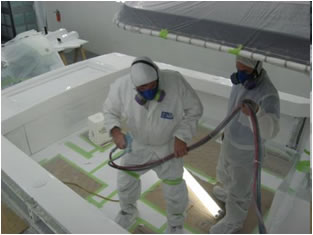Protective Coatings
To learn about paint standards and related coating standards that exist for marine coatings it is recommenced to visit the ASTM website and jump to Marine Coatings. There you will find ten different standards regarding different types of coatings and performance parameters.
"http://www.astm.org/Standards/paint-and-related-coating-standards.html": Paint Standards and Related Coating Standards.
This group feels that ASTM 4939 is the most applicable test for analysing how a coating with perform in a given environment. In addition, our investigations have found that Poseidon Sciences Group has adapted this ASTM method to better suit its needs.
There are many marine coating options for engineers and operators to select from. Most of the coatings found by this group fall under two categories. These are Controlled Depletion Polymers (CDPs), Self Polishing Copolymers (SPCs), Foul Release Coatings (FRCs) and Hard Paint. A paper summarizing most of these is “Modern approaches to marine antifouling coatings” by L.D. Chambers, K.R. Stokes, F.C. Walsh and R.J.K. Wood.

Performance Considerations
Antifouling performance
- Roughness & Speed at which organisms detach
- Biocide strength and ability to stop growth
Durability
- Cavitation resistance
- Erosion resistance
- Flexibility and coldflow resistance
Financial Considerations
- Amount of layers and base layers
- Labor & Recoating process
- Cost/surface area
- Longevity
Boat Bottom Coatings
CDP: |
Interspeed |
SPC: |
CopperCOAT |
|
Ultra-Coat |
|
Trinidad SR |
FRC: |
Intersleek |
|
Nanocyl |
|
Sharklet |
|
Sealcoat |
Hard Paint-Glass Flakes: |
Ecospeed |
References:
http://eprints.soton.ac.uk/43767/1/our_anti-fouling.pdf





